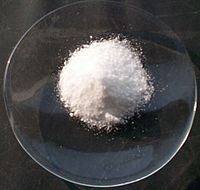
Photo from wikipedia
Abstract The behaviour of chlorine and bromine isotopes in evaporite deposits differs significantly. We studied the isotope variations of both elements in a fully developed natural salt sequence from Zechstein… Click to show full abstract
Abstract The behaviour of chlorine and bromine isotopes in evaporite deposits differs significantly. We studied the isotope variations of both elements in a fully developed natural salt sequence from Zechstein evaporite deposits (Wuchiapingian, Upper Permian) in the Northern Netherlands. We observed that the Cl isotope variations follow previously predicted characteristics, showing slightly positive δ37Cl (relative to seawater) in halite (NaCl) dominated layers (up to +0.05‰), decreasing to moderately negative values in carnallite (KMgCl3·6H2O) and bischofite (MgCl2·6H2O) dominated layers (down to −0.55‰). Bromine isotope variations, the first ever measured in marine evaporite samples, show a different characteristic. δ81Br values decrease quickly in layers dominated by halite (from +0.2 to −0.5‰) and increase again in layers dominated by carnallite and bischofite (up to −0.1 ± 0.2‰). These observations suggest that the Br isotope fractionation (103lnα) during precipitation of halite can be as high as +1.3, 3.8 times as large as Cl isotope fractionation. The increasing δ81Br values during precipitation of magnesium salts may suggest a negative fractionation (103lnα) of −0.9, meaning that the Br isotope ratio in the precipitated salt is lower than in the brine. We suggest that the difference in behaviour between Cl and Br can be explained by the fact that Br, as a minor component in the brine, has to compete with Cl to fit into the crystal lattice of Cl salts, where it does not fit perfectly due to its slightly larger ionic radius than Cl, resulting in relatively large isotope fractionation. Further research is however needed to confirm or reject this suggestion.
Journal Title: Geochimica et Cosmochimica Acta
Year Published: 2019
Link to full text (if available)
Share on Social Media: Sign Up to like & get
recommendations!